check engine PEUGEOT 3008 2014 Owners Manual
[x] Cancel search | Manufacturer: PEUGEOT, Model Year: 2014, Model line: 3008, Model: PEUGEOT 3008 2014Pages: 389, PDF Size: 22.92 MB
Page 5 of 389
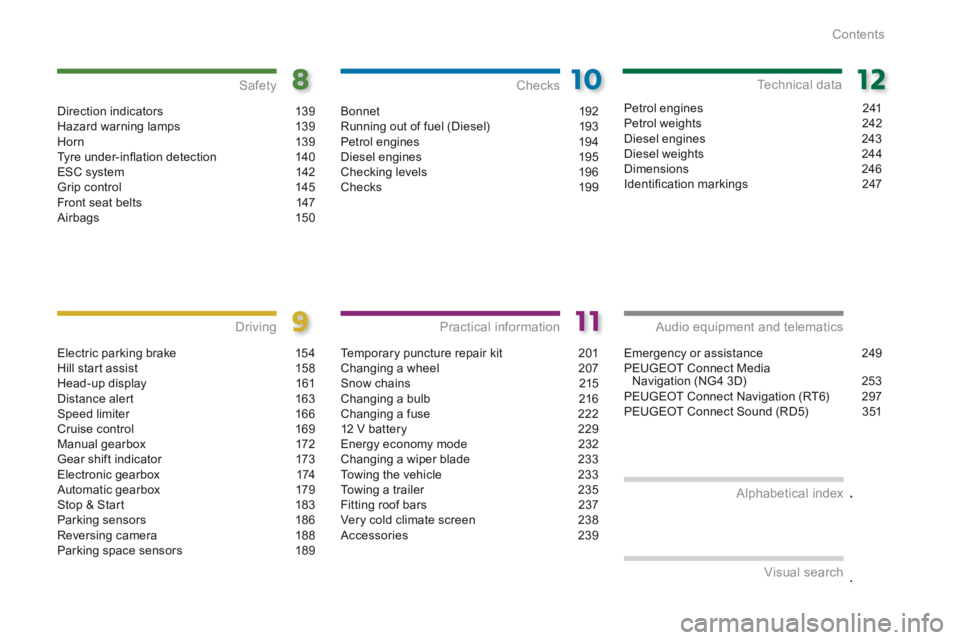
.
.
Contents
Direction indicators 139Hazard warning lamps 139H or n 13 9Tyre under-infl ation detection 140ESC system 142Grip control 145Front seat belts 147Airbags 150
Safety
Electric parking brake 154Hill start assist 158Head-up display 161Distance alert 163Speed limiter 166Cruise control 169Manual gearbox 172Gear shift indicator 173Electronic gearbox 174Automatic gearbox 179Stop & Start 183Parking sensors 186Reversing camera 188Parking space sensors 189
Driving
Emergency or assistance 249PEUGEOT Connect Media Navigation (NG4 3D) 253PEUGEOT Connect Navigation (RT6) 297PEUGEOT Connect Sound (RD5) 351
Audio equipment and telematics
Visual search
Alphabetical index
Bonnet
192Running out of fuel (Diesel) 193Petrol engines 194Diesel engines 195Checking levels 196Checks 19 9
Checks
Temporary puncture repair kit 201Changing a wheel 207Snow chains 215Changing a bulb 216Changing a fuse 22212 V battery 229Energy economy mode 232Changing a wiper blade 233Towing the vehicle 233Towing a trailer 235Fitting roof bars 237Very cold climate screen 238Accessories 239
Practical information
Petrol engines 241Petrol weights 242Diesel engines 243Diesel weights 244Dimensions 246Identifi cation markings 247
Technical data
Page 23 of 389
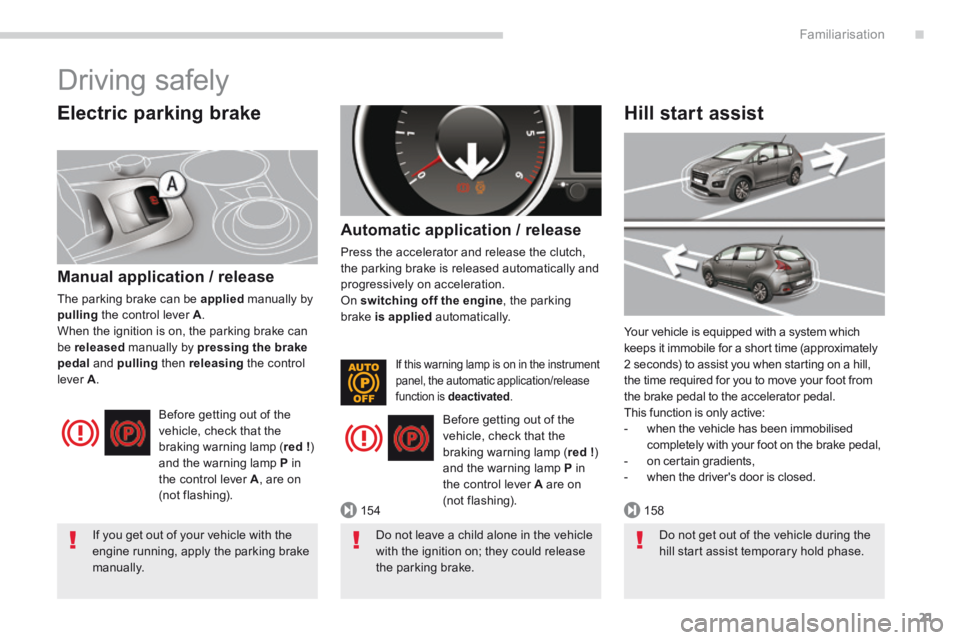
.
154158
Familiarisation21
Electric parking brake
Manual application / release
The parking brake can be applied manually by pulling the control lever A . When the ignition is on, the parking brake can be released manually by pressing the brake pedal and pulling then releasing the control lever A .
Automatic application / release
Press the accelerator and release the clutch, the parking brake is released automatically and progressively on acceleration. On switching off the engine , the parking brake is applied automatically.
Before getting out of the vehicle, check that the braking warning lamp ( red ! ) and the warning lamp P in the control lever A , are on (not flashing).
Before getting out of the
vehicle, check that the braking warning lamp ( red ! ) and the warning lamp P in the control lever A are on (not flashing).
Your vehicle is equipped with a system which keeps it immobile for a short time (approximately 2 seconds) to assist you when starting on a hill, the time required for you to move your foot from the brake pedal to the accelerator pedal. This function is only active: - when the vehicle has been immobilised completely with your foot on the brake pedal, - on certain gradients, - when the driver's door is closed.
Hill start assist
If this warning lamp is on in the instrument panel, the automatic application/release function is deactivated .
Driving safely
If you get out of your vehicle with the engine running, apply the parking brake manually.
Do not leave a child alone in the vehicle with the ignition on; they could release the parking brake.
Do not get out of the vehicle during the hill start assist temporary hold phase.
Page 28 of 389
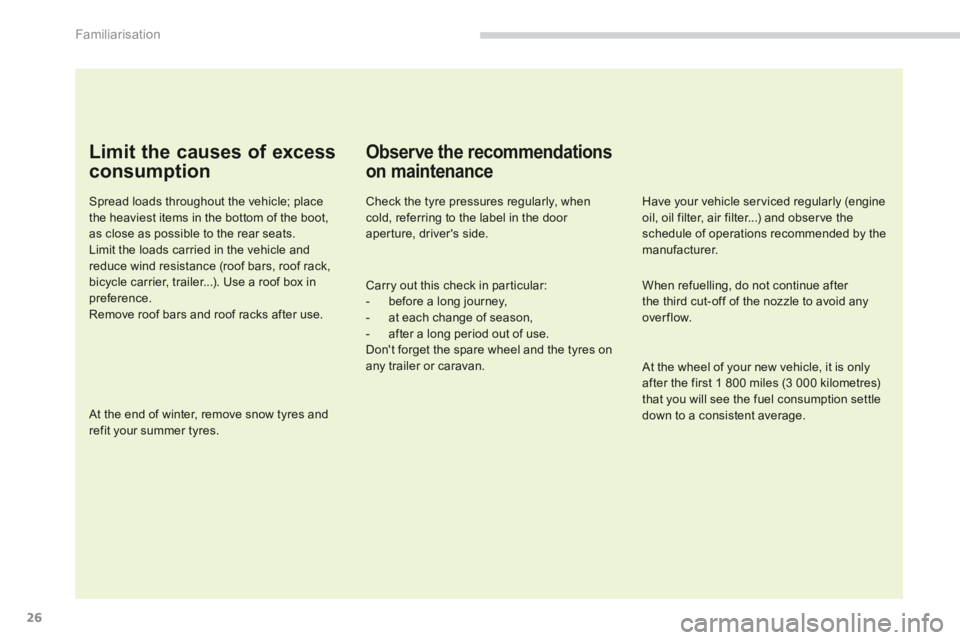
Familiarisation
26
Limit the causes of excess
consumption
Spread loads throughout the vehicle; place the heaviest items in the bottom of the boot, as close as possible to the rear seats. Limit the loads carried in the vehicle and reduce wind resistance (roof bars, roof rack, bicycle carrier, trailer...). Use a roof box in preference. Remove roof bars and roof racks after use.
At the end of winter, remove snow tyres and refit your summer tyres.
Observe the recommendations
on maintenance
Check the tyre pressures regularly, when cold, referring to the label in the door aperture, driver's side.
Have your vehicle serviced regularly (engine oil, oil filter, air filter...) and observe the schedule of operations recommended by the manufacturer.
When refuelling, do not continue after the third cut-off of the nozzle to avoid any over flow.
At the wheel of your new vehicle, it is only after the first 1 800 miles (3 000 kilometres) that you will see the fuel consumption settle down to a consistent average.
Carry out this check in particular: - before a long journey, - at each change of season, - after a long period out of use. Don't forget the spare wheel and the tyres on any trailer or caravan.
Page 38 of 389
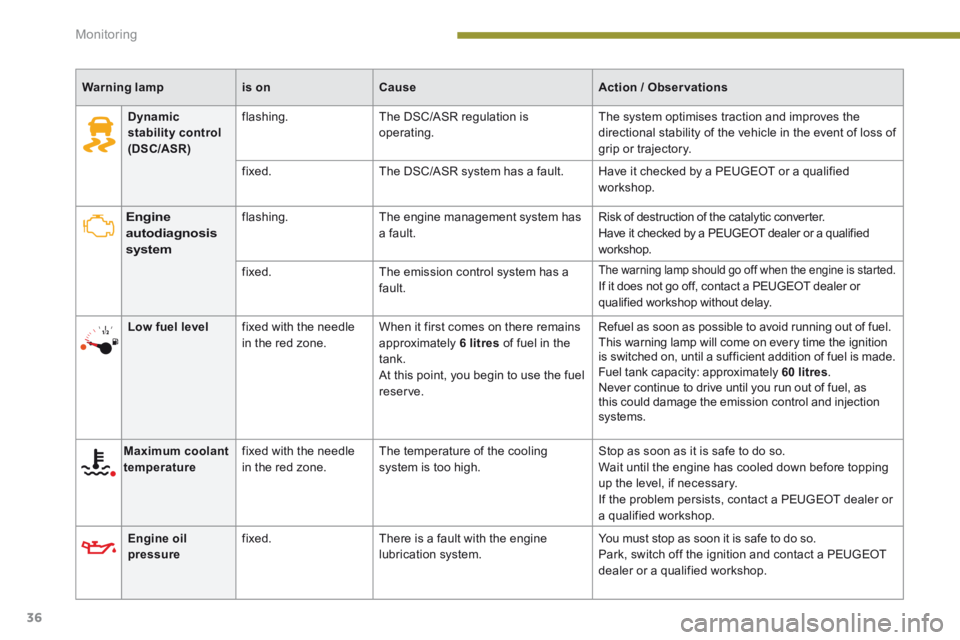
Monitoring
36
Warning lampis onCauseAction / Observations
Engine autodiagnosis system
flashing. The engine management system has a fault. Risk of destruction of the catalytic converter. Have it checked by a PEUGEOT dealer or a qualified workshop.
fixed. The emission control system has a fault.
The warning lamp should go off when the engine is started. If it does not go off, contact a PEUGEOT dealer or qualified workshop without delay.
Low fuel level fixed with the needle in the red zone. When it first comes on there remains approximately 6 litres of fuel in the tank. At this point, you begin to use the fuel reserve.
Refuel as soon as possible to avoid running out of fuel. This warning lamp will come on every time the ignition is switched on, until a sufficient addition of fuel is made. Fuel tank capacity: approximately 60 litres . Never continue to drive until you run out of fuel, as this could damage the emission control and injection systems.
Maximum coolant temperature fixed with the needle in the red zone. The temperature of the cooling system is too high. Stop as soon as it is safe to do so. Wait until the engine has cooled down before topping up the level, if necessary. If the problem persists, contact a PEUGEOT dealer or a qualified workshop.
Engine oil pressure fixed. There is a fault with the engine lubrication system. You must stop as soon it is safe to do so. Park, switch off the ignition and contact a PEUGEOT dealer or a qualified workshop.
Dynamic stability control (DSC/ASR)
flashing. The DSC/ASR regulation is operating. The system optimises traction and improves the directional stability of the vehicle in the event of loss of grip or trajectory.
fixed. The DSC/ASR system has a fault. Have it checked by a PEUGEOT or a qualified workshop.
Page 39 of 389

1
Monitoring37
Warning lampis onCauseAction / Observations
Battery charge fixed. The battery charging circuit has a fault (dirty or loose terminals, slack or cut alternator belt, ...).
The warning lamp should go off when the engine is started. If it does not go off, contact a PEUGEOT dealer or a qualified workshop.
Door(s) open fixed if the speed is below 6 mph (10 km/h). A door, the boot, the lower tailgate or the bonnet (with alarm only) is still open.
Close the door or boot.
fixed and accompanied by an audible signal if the speed is above 6 mph (10 km/h).
Seat belt not fastened / unfastened
fixed then flashing accompanied by an increasing audible signal.
The driver and/or the front passenger has not fastened or has unfastened their seat belt.
Pull the strap then insert the tongue in the buckle.
Airbags on temporarily. This lamp comes on for a few seconds when you turn on the ignition, then goes off.
This lamp should go off when the engine is started. If it does not go off, contact a PEUGEOT dealer or a qualified workshop.
fixed. One of the airbag or seat belt pretensioner systems has a fault. Have it checked by a PEUGEOT dealer or a qualified workshop.
Water in Diesel fixed. The Diesel fuel filter contains water. Risk of damage to the injection system on Diesel engines. Contact a PEUGEOT dealer or a qualified workshop without delay.
Page 40 of 389
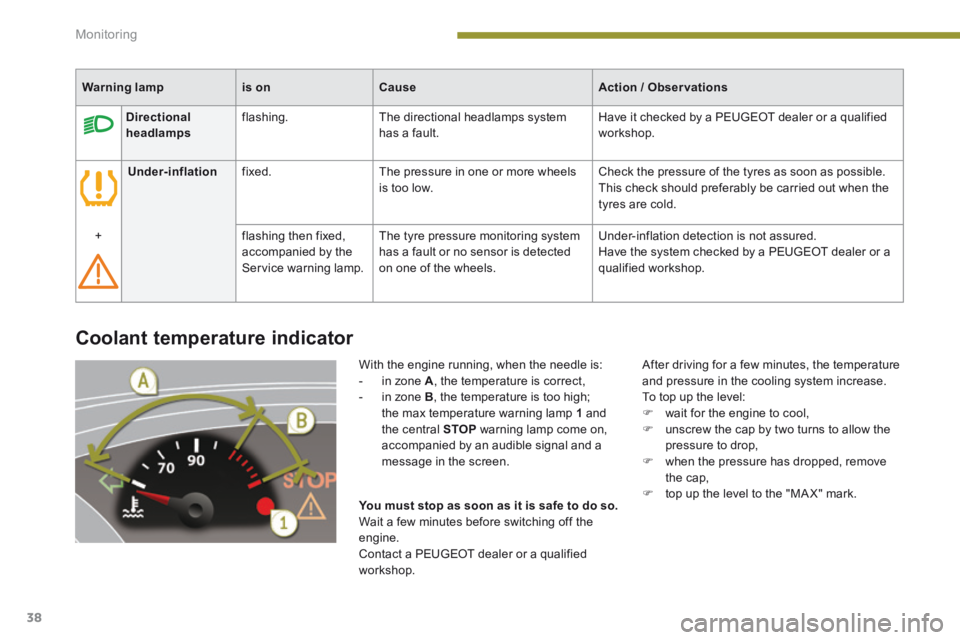
Monitoring
38
Coolant temperature indicator
With the engine running, when the needle is: - in zone A , the temperature is correct, - in zone B , the temperature is too high; the max temperature warning lamp 1 and the central STOP warning lamp come on, accompanied by an audible signal and a message in the screen.
After driving for a few minutes, the temperature and pressure in the cooling system increase. To top up the level: wait for the engine to cool, unscrew the cap by two turns to allow the pressure to drop, when the pressure has dropped, remove the cap, top up the level to the "MA X" mark. You must stop as soon as it is safe to do so. Wait a few minutes before switching off the
engine. Contact a PEUGEOT dealer or a qualified workshop.
Warning lampis onCauseAction / Observations
Directional headlamps flashing. The directional headlamps system has a fault. Have it checked by a PEUGEOT dealer or a qualified workshop.
Under-inflation fixed. The pressure in one or more wheels is too low. Check the pressure of the tyres as soon as possible. This check should preferably be carried out when the tyres are cold.
+ flashing then fixed, accompanied by the Service warning lamp.
The tyre pressure monitoring system has a fault or no sensor is detected on one of the wheels.
Under-inflation detection is not assured. Have the system checked by a PEUGEOT dealer or a qualified workshop.
Page 43 of 389
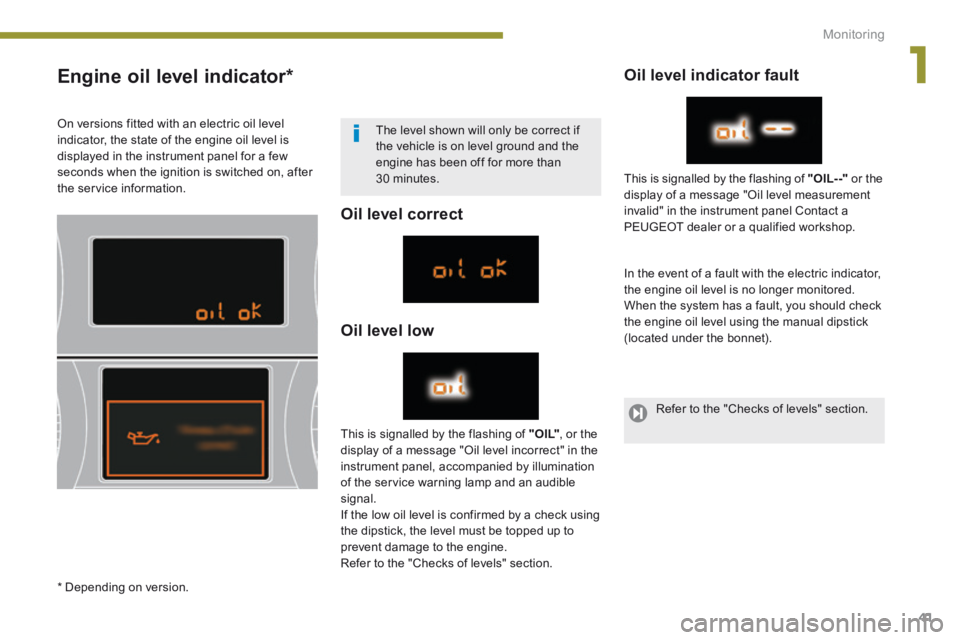
1
Monitoring41
Engine oil level indicator *
Oil level correct
Oil level low
Oil level indicator fault
In the event of a fault with the electric indicator, the engine oil level is no longer monitored. When the system has a fault, you should check the engine oil level using the manual dipstick (located under the bonnet).
This is signalled by the flashing of " O I L" , or the display of a message "Oil level incorrect" in the instrument panel, accompanied by illumination of the service warning lamp and an audible signal. If the low oil level is confirmed by a check using the dipstick, the level must be topped up to
prevent damage to the engine. Refer to the "Checks of levels" section.
This is signalled by the flashing of "OIL- -" or the display of a message "Oil level measurement invalid" in the instrument panel Contact a
PEUGEOT dealer or a qualified workshop.
On versions fitted with an electric oil level indicator, the state of the engine oil level is displayed in the instrument panel for a few seconds when the ignition is switched on, after the service information.
The level shown will only be correct if the vehicle is on level ground and the engine has been off for more than 30 minutes.
* Depending on version.
Refer to the "Checks of levels" section.
Page 60 of 389
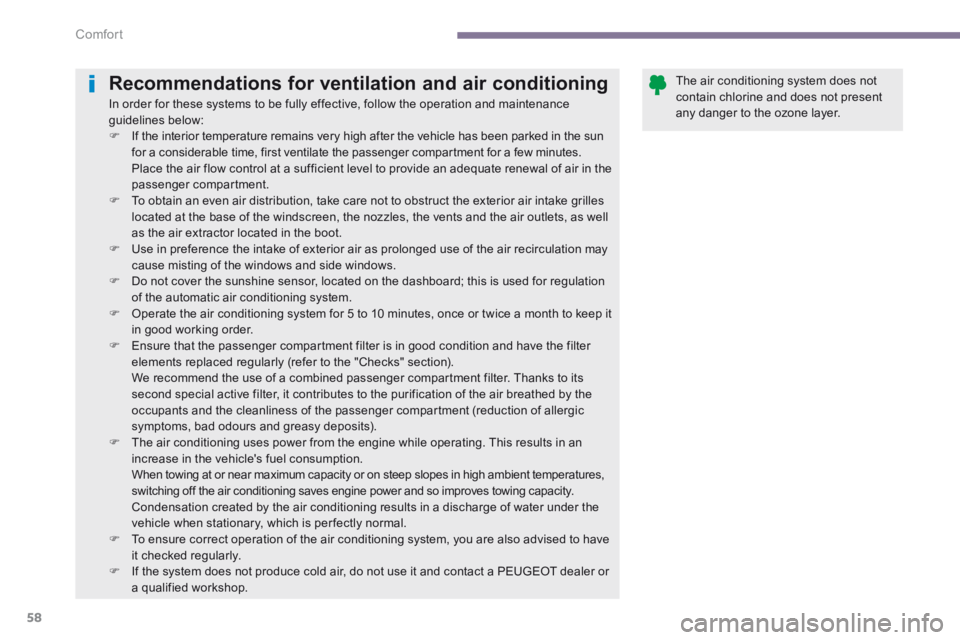
Comfort
58
Recommendations for ventilation and air conditioning
In order for these systems to be fully effective, follow the operation and maintenance guidelines below: If the interior temperature remains very high after the vehicle has been parked in the sun for a considerable time, first ventilate the passenger compartment for a few minutes. Place the air flow control at a sufficient level to provide an adequate renewal of air in the passenger compartment. To obtain an even air distribution, take care not to obstruct the exterior air intake grilles located at the base of the windscreen, the nozzles, the vents and the air outlets, as well as the air extractor located in the boot. Use in preference the intake of exterior air as prolonged use of the air recirculation may cause misting of the windows and side windows. Do not cover the sunshine sensor, located on the dashboard; this is used for regulation of the automatic air conditioning system. Operate the air conditioning system for 5 to 10 minutes, once or twice a month to keep it in good working order. Ensure that the passenger compartment filter is in good condition and have the filter elements replaced regularly (refer to the "Checks" section). We recommend the use of a combined passenger compartment filter. Thanks to its second special active filter, it contributes to the purification of the air breathed by the occupants and the cleanliness of the passenger compartment (reduction of allergic symptoms, bad odours and greasy deposits).
The air conditioning uses power from the engine while operating. This results in an increase in the vehicle's fuel consumption. When towing at or near maximum capacity or on steep slopes in high ambient temperatures, switching off the air conditioning saves engine power and so improves towing capacity. Condensation created by the air conditioning results in a discharge of water under the vehicle when stationary, which is per fectly normal. To ensure correct operation of the air conditioning system, you are also advised to have it checked regularly. If the system does not produce cold air, do not use it and contact a PEUGEOT dealer or
a qualified workshop.
The air conditioning system does not contain chlorine and does not present any danger to the ozone layer.
Page 82 of 389
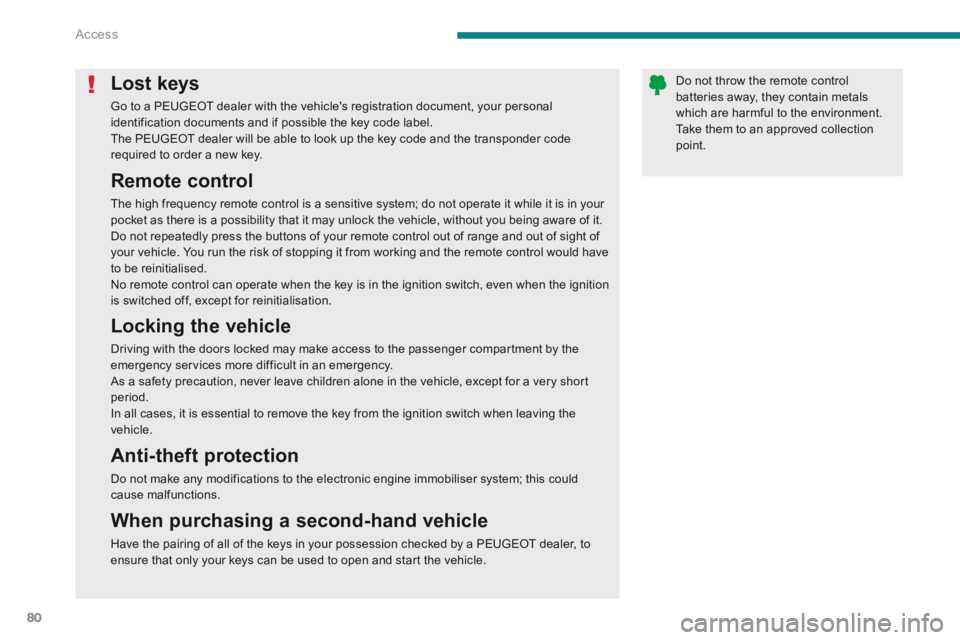
Access
80
Lost keys
Go to a PEUGEOT dealer with the vehicle's registration document, your personal identification documents and if possible the key code label. The PEUGEOT dealer will be able to look up the key code and the transponder code required to order a new key.
Do not throw the remote control batteries away, they contain metals which are harmful to the environment. Take them to an approved collection point.
Remote control
The high frequency remote control is a sensitive system; do not operate it while it is in your pocket as there is a possibility that it may unlock the vehicle, without you being aware of it. Do not repeatedly press the buttons of your remote control out of range and out of sight of your vehicle. You run the risk of stopping it from working and the remote control would have to be reinitialised. No remote control can operate when the key is in the ignition switch, even when the ignition is switched off, except for reinitialisation.
Locking the vehicle
Driving with the doors locked may make access to the passenger compartment by the emergency services more difficult in an emergency. As a safety precaution, never leave children alone in the vehicle, except for a very short period. In all cases, it is essential to remove the key from the ignition switch when leaving the vehicle.
Anti-theft protection
Do not make any modifications to the electronic engine immobiliser system; this could cause malfunctions.
When purchasing a second-hand vehicle
Have the pairing of all of the keys in your possession checked by a PEUGEOT dealer, to ensure that only your keys can be used to open and start the vehicle.
Page 92 of 389
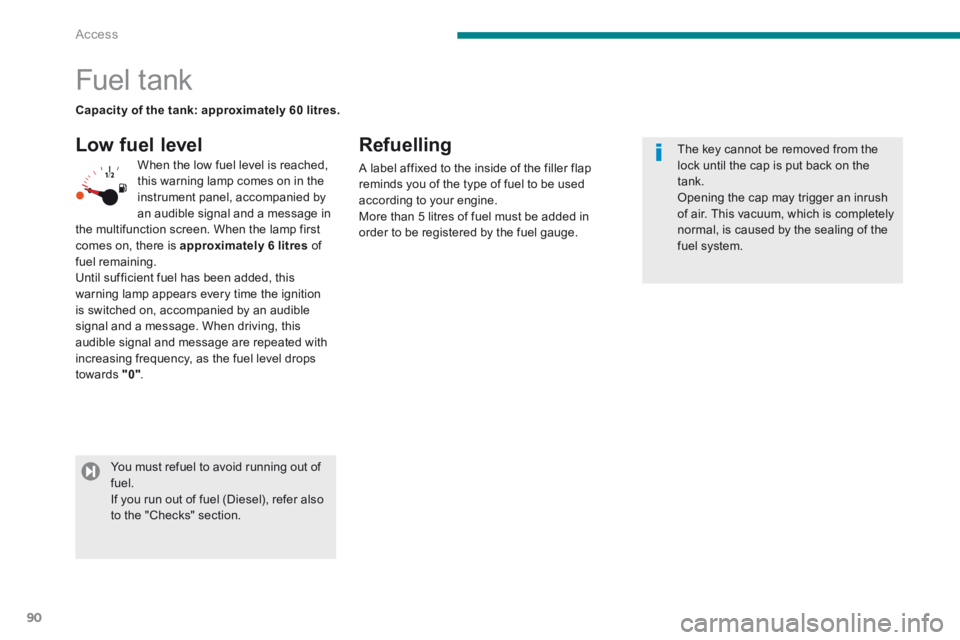
Access
90
Fuel tank
Low fuel level Refuelling
A label affixed to the inside of the filler flap reminds you of the type of fuel to be used according to your engine. More than 5 litres of fuel must be added in order to be registered by the fuel gauge.
When the low fuel level is reached, this warning lamp comes on in the instrument panel, accompanied by an audible signal and a message in the multifunction screen. When the lamp first comes on, there is approximately 6 litres of fuel remaining. Until sufficient fuel has been added, this warning lamp appears every time the ignition is switched on, accompanied by an audible signal and a message. When driving, this audible signal and message are repeated with increasing frequency, as the fuel level drops towards "0" .
Capacity of the tank: approximately 60 litres.
You must refuel to avoid running out of fuel. If you run out of fuel (Diesel), refer also to the "Checks" section.
The key cannot be removed from the lock until the cap is put back on the tank. Opening the cap may trigger an inrush of air. This vacuum, which is completely
normal, is caused by the sealing of the fuel system.